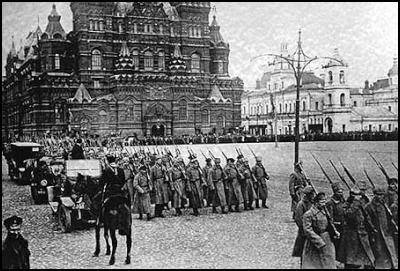1917: year of war, revolution and myriad legacies
Thursday, November 10, 2016
1917: year of war, revolution and myriad legacies

Image from the Russian
Revolution (Wikimedia)
1917 is synonymous with World War One, but it was a watershed year for other reasons, including the Russian Revolution, suffragette protests in America and the shock impact of a French artist’s urinal sculpture.
These are among seminal events explored in a special symposium in Wellington next April.
Titled ‘The Myriad Faces of War: 1917 and its legacy’, this international and multidisciplinary symposium brings together an eclectic range of speakers from the around the world to explore the many themes and faces from the First World War (aka the Great War) and associated events.
Held at Te Papa Tongarewa from April 25 to 28, the event is jointly organised by WHAM (War History Heritage Art and Memory) Research Network; Massey University; Auckland War Memorial Museum; the University of Auckland and Ministry for Culture and Heritage.
Passchendaele to Palestine
A diverse programme embraces topics as wide-ranging as propaganda to poetry and patriotic songs, the horrendous death toll on the Western Front at Passchendaele to the fate of Palestine and the birth of modern Iraq as well as revolution in Russia. As well as the advent of plastic surgery to repair maimed soldiers, submarine warfare, the impact of war in Germany and Latin America, as well as New Zealand’s emerging national identity and mythology, memorialisation and masculinity are also among some 60 presentations.
“The symposium examines a single year, 1917, and expands outwards to reflect on the significant impact of the Great War and associated events, and the way in which particular actions contributed to a reordering of global structures that have reverberated through the intervening century to the present,” says organising committee member Professor Kingsley Baird, a senior lecturer in the School of Design at Massey’s College of Creative Arts.
In 1917, the global reach of the Great War expanded as United States, China, Brazil, and others joined the Allied side. On the battlefield, combatants experienced exhilarating triumphs and devastating losses from Passchendaele to Cambrai on the Western Front, at Caporetto on the Austro-Italian Front, and Beersheba and Ramadi in the Middle East.
Revolutions in politics and art
Post-war political and social changes were signalled with the imminent collapse of the Austro-Hungarian and Ottoman empires, and when Russia – in the midst of a communist revolution – withdrew from the war. The Balfour Declaration pledged Britain's support for a national home for the Jewish people in Palestine; suffragettes in Washington were arrested as they picketed the White House; and conscientious objectors from New Zealand were shipped to the Western Front in an attempt to force them to join the war effort.
On the cultural landscape, French conceptual artist Marcel Duchamp redefined art with the Fountain urinal; the art and literature review Dada was published in Zurich; and soldier poet, Wilfred Owen, wrote Anthem for Doomed Youth.
Well-known New Zealand figures in war, memory and cultural studies, include Jock Phillips, Monty Soutar and Professor Glyn Harper. They will be joined by international war and culture studies specialists, including Professors Jay Winter, Annette Becker and Michael Nieberg.
“The narrative of 1917 and its legacy is characterised by a multitude of perspectives, practices, cultures, histories, locations and expressions,” says Professor Baird. “It is unlikely such a gathering of knowledge on the First World War will assemble again in New Zealand for some time.”
Registration for Myriad Faces costs $390 before January 9, 2017, or $450 after this date. Check the website for more information or to register at: myriadfaces.org


 Whanganui Regional Museum: Historic Wedding Dress Unveiled, A Piece Of Marton’s Heritage
Whanganui Regional Museum: Historic Wedding Dress Unveiled, A Piece Of Marton’s Heritage Donovan Ryan: Local Runner Takes Out Frontrunner Christchurch Marathon
Donovan Ryan: Local Runner Takes Out Frontrunner Christchurch Marathon University of Auckland: Tributes Flow For Much Loved Pacific Leader Melegalenu’u Ah Sam
University of Auckland: Tributes Flow For Much Loved Pacific Leader Melegalenu’u Ah Sam NZEI: Ministry Of Education Cuts Will Disproportionately Affect Pasifika
NZEI: Ministry Of Education Cuts Will Disproportionately Affect Pasifika Day One Hapai te Haeata: Call To Action For Young Filmmakers Against The Backdrop Of Funding Cuts
Day One Hapai te Haeata: Call To Action For Young Filmmakers Against The Backdrop Of Funding Cuts Toyota New Zealand: Three Races For Top Three To Decide TR86 Title
Toyota New Zealand: Three Races For Top Three To Decide TR86 Title